Fourteen Ways That Spiders Use Their Silk
Spider silk is a wonder material that, weight for weight, is stronger than steel, tougher than Kevlar and can be more elastic than rubber. It’s also flexible and antimicrobial. Scientists have used silk to make bulletproof armor, violin strings, medical bandages, optical fiber cables and even extravagant clothing.
“I don’t think people would believe you if you told them, there’s this creature that, if you scaled it up … to the size of the human, it could catch an aeroplane with the material that it makes itself out of itself,” says Fritz Vollrath, an evolutionary biologist at the University of Oxford.
Spider silk is made of a blend of different proteins linked together into a chain, produced by special glands call spinnerets on the spider’s rear end. All spiders produce silk (some spiders can produce several different kinds), but not necessarily as webs like those depicted in Halloween decorations.
Here are some bizarre ways spiders use their silk beyond the static webs they employ to snag their prey.
As Cords and Nets to Actively Snare Prey
https://www.youtube.com/watch?v=CGdMRXQOk18; or https://www.youtube.com/watch
Silk as a passive web for bugs to fly into may be the least interesting spider hunting method of all. To catch their next meal, spiders may use their silk as nets—or as lassos, whips, binds, disguises, fishing lines and lures.
Most spiders avoid ants because they are often predatory themselves, but one family of spiders treats ants as chow. When the wall spider (Oecobius) gets an ant alone, it runs circles around its victim, all the while churning out a silk cord and wrapping the ant from a safe distance. After the ant is all trundled up, the spider goes in for the kill by chomping the ant at the base of the antennae.
The ogre-faced spider (Deinopis) spins a web as a snare, but deploys it in an unusual way. It weaves a web between its four front legs, holds the creation wide open while hanging upside down and waits. Once an insect wanders by, it snaps up its prey using its web as a net. This net-casting hunter can catch prey wandering beneath or even flying in mid-air, like a lacrosse player captures a ball. Then the victorious spider bundles up its prey and kills it.
As Parachutes
In 1883, the Krakatoa volcano in present-day Indonesia erupted with the force of over 10,000 hydrogen bombs, obliterating most of the island and converting it into a lifeless wasteland. Three months later, visiting scientists were surprised to find one lifeform present in the region: microscopic spiders.
These spiders weren’t on the newborn island because they survived the blast. Rather, they had travelled there in the aftermath of the eruption—by ballooning. Now a well-known phenomenon, ballooning occurs when spiders stream their silk into the air, catching the winds like a sail for loft. Spiders have been found in the middle of the ocean, hitching a ride on the jet stream and on remote islands hundreds of miles from the mainland. Not all spiders balloon to travel extreme distances—some rely on it to flee from predators or cover short lengths without expending much energy.
When a spider balloons, it literally tiptoes and hoists its abdomen towards the skies. It doesn’t always need favorable winds to kite off (breezes are better than gusts), but instead relies on electrostatic repulsion to generate most of the lift. Spider silk is negatively charged, similar to the surface of the Earth that’s negatively charged up by the 40,000 daily thunderstorms around the world. Like charges repel, so the force pushes the silk off the ground to help the spider take flight. Spiders can sense electric fields with the hairs on their legs, so they may lift a limb to survey the atmospheric conditions before executing a great escape.
As Home Décor
An orb-weaver spider found in the Uluguru Mountains in Tanzania spins a web embellished with dense stripes of silk. Muhammad Mahdi Karim via Wikimedia Commons under GFDLv1.2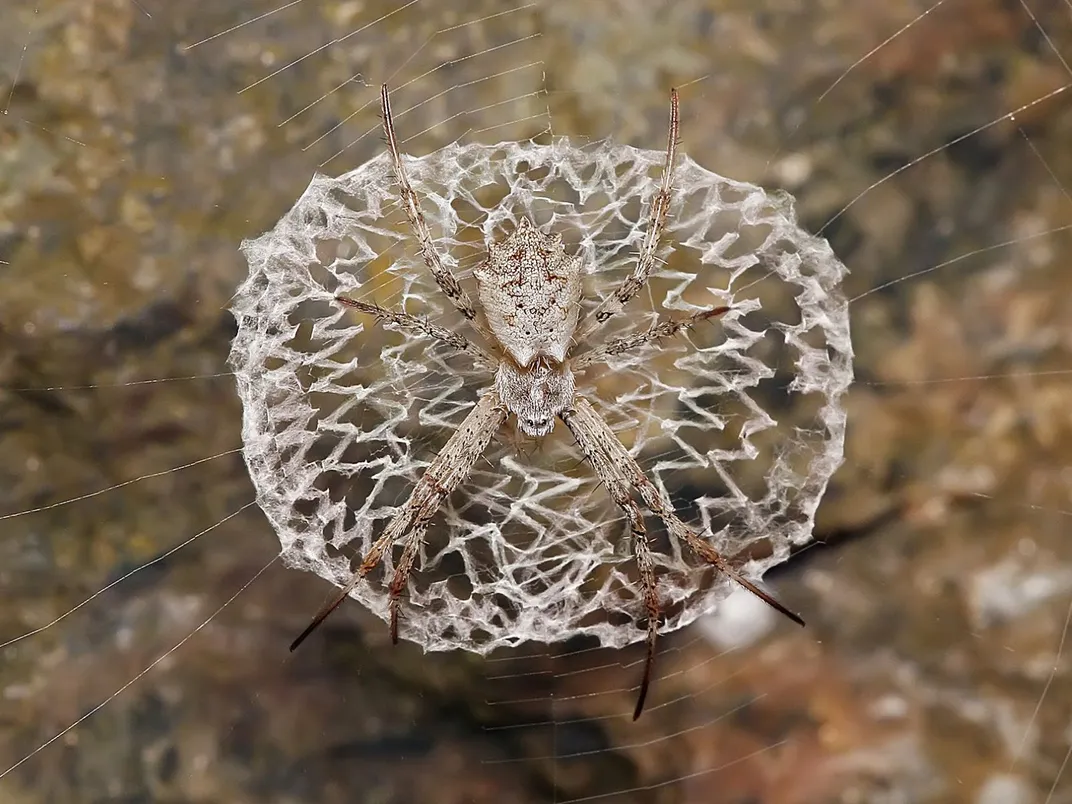
Orb-weaving spiders don’t just construct their homes from silk. Some of these spiders make an effort to decorate it too. They weave throughout their webs stripes of thickly banded silk called stabilimenta. Scientists first though these structures worked to stabilize the web, but the theory was disproved after they found that the patterns were only loosely knitted intro the web’s fabric. Today, the function of stabilimenta is still a mystery.
But several hypotheses seek to explain it. Since the stabilimenta are woven only by daytime-roaming spiders, researchers have guessed that these spiders intend for their elaborate web designs to be seen. The popping patterns may be used to camouflage the spiders by obscuring the silhouette of the spider. Scientists think they may also increase the perceived size of the spider. Other leading theories include that these structures reflect more ultraviolet light in the same way flowers and foliage do, attracting more insects to the structures. Alternatively, they could serve as a stop sign so birds don’t accidentally fly into and damage the web. The downside of these woven motifs is that they seem to also draw more spider-eating spiders by making a web look more conspicuous to these visual hunters.
As Protection from the Elements
A Carrhotus jumping spider hides in a “pup tent.” Leana Lahom-Cristobal / Project Noah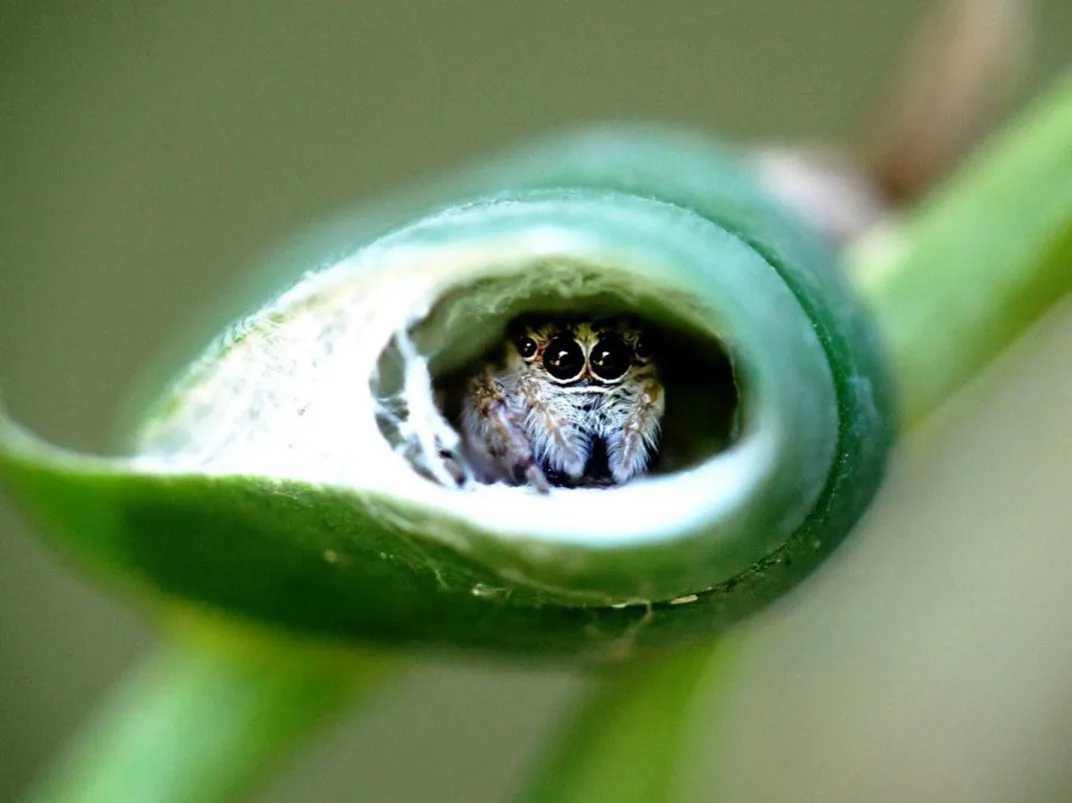
Jumping spiders roam freely during the day, but at night or in the midst of cold or rain, they will spin themselves a silken shelter. Jumping spiders use these “pup tents” to shed their external shell safely, store their egg sacs or hibernate. One scientist has speculated that the ability to spin cozy cocoons that insulate the spider from the cold is one reason the Himalayan jumping spider (Euophrys omnisuperstes) can survive the frigid temperatures at elevations of 22,000 feet, making it one of the highest-dwelling, non-migratory animals in the world.
As Buffers Against Tides
The Desis martensi spider lives in the intertidal zone on rocky beaches. Ria Tan and wildsingapore.com via Flickr under CC BY-NC-ND 2.0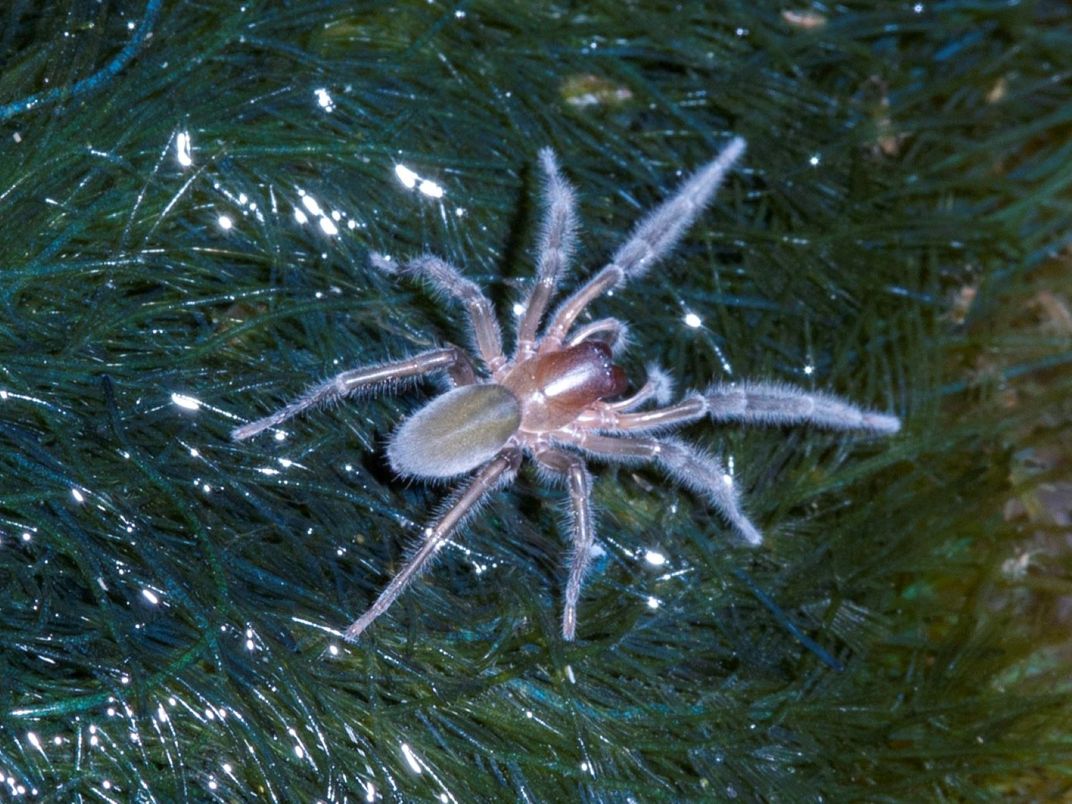
One spider spins cocoons to protect itself from the daily tides where it dwells. The Desis spiders scuttle amidst coral, abandoned seashells and the bottoms of kelp on the beach during low tides. When the water rises, the spiders seal themselves in these nooks and crannies with waterproof silk. Researchers have found that the spider lowers its breathing to reduce how fast it burns through the oxygen in its air pocket. Scientists still have questions—such as how the web can withstand salt or how the spider keeps time with the tide.
As Underwater Breathing Tanks
A diving bell spider feasts on a stickle-back in its underwater home. Oxford Scientific via Getty Images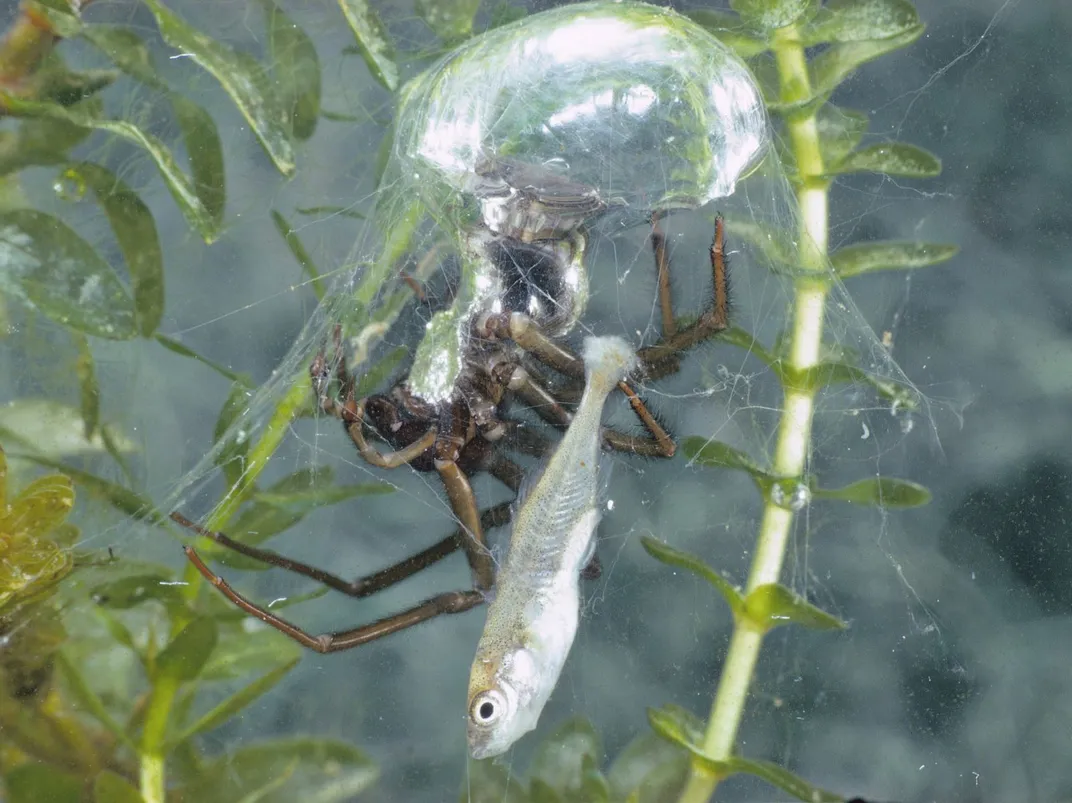
Only one arachnid lives most of its life underwater: the diving bell spider (Argyroneta aquatica). Like all other terrestrial spiders, it only breathes air. Before it submerges, it gloms a bubble onto its posterior as a temporary scuba tank. For a longer-term solution, it spins an air-filled, dome-shaped diving bell with silk on aquatic vegetation as its underwater home.
Diving bell spiders pump up their homes using bubbles they gather from the water surface. Their silken lair permits the exchange of gas molecules to the surrounding water. Scientists have measured oxygen diffusing into the diving bell and carbon dioxide diffusing out to facilitate a spider’s breathing. For this reason, scientists have even likened the homespun structure to a gill. In oxygen-poor waters, these spiders will expand the size of their homes to stuff in more air. Although the gas exchange is efficient, eventually the diving bells shrink, so the spiders need to resurface once a day to gather bubbles for reinflation.
As Door Hinges to Burrows
A trapdoor spider peeks out from the doorway of its burrow. Louise Docker, Sydney, Australia via Getty Images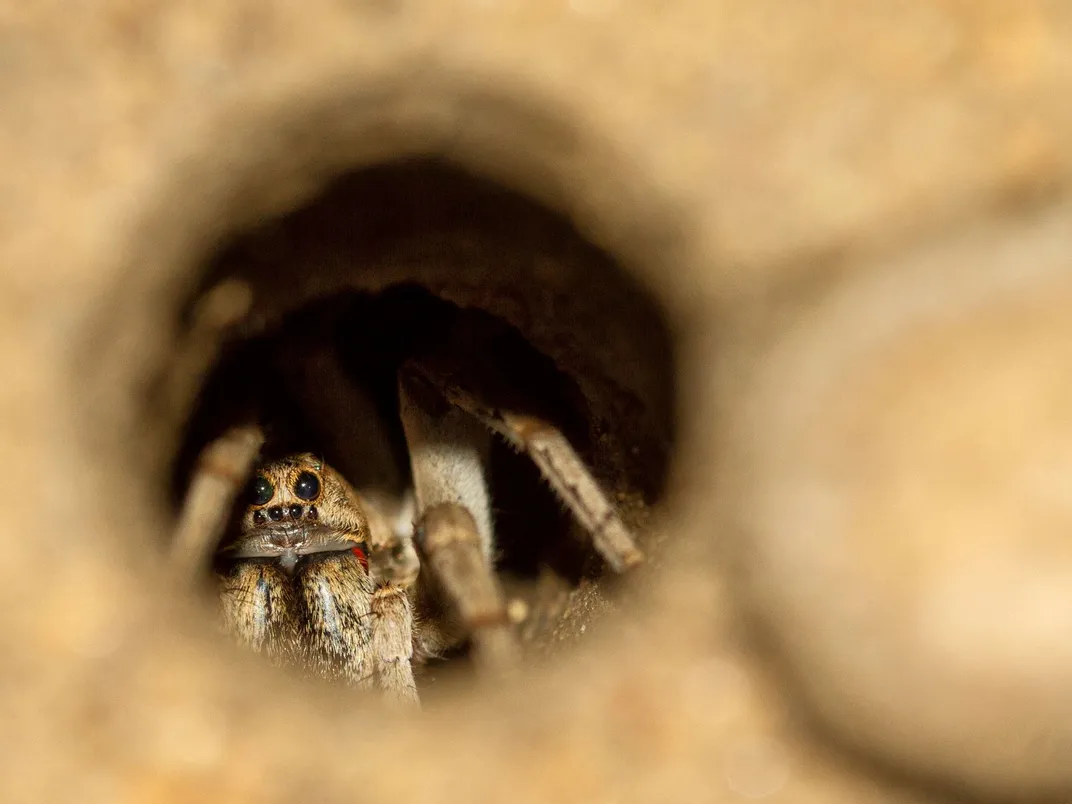
“Trapdoor spiders and tarantulas will use silks to reinforce the tunnels that they make. So it’s like a building material,” says Sebastian Echeverri, a spider researcher and communicator. Among his 19 pet spiders, his favorites are his two trapdoor spiders.
This kind of spider furnishes its home with a solid door made of soil, leaves and silk. The hinge of the door in particular is spun from silk. These arachnids keep the door shut in the morning and leave it open as they hunt at night, when the spiders are most active. Radiating from the entryway are trails of silk threads that act as trip lines. When a victim touches these threads, the ambush hunters will sense their vibrations through the silk and pounce.
The doors serve as protection, especially against their predatory arch nemesis: parasitic wasps. In the event of an attack, the trapdoor spiders use their fangs to hold the door shut—a move oddly reminiscent of a grumpy human teenager. But the stinging predators usually win out by chewing through the flap. The oldest known spider in the wild, a trapdoor spider residing in southwest Australia, died in 2016 at the age of 43 when it was killed by a parasitic wasp that raided its home.
As Community Hubs
The webs of the social Anelosimus eximus spiders, such as this one found in Yasuni National Park in Ecuador, can stretch up to 25 feet in length to accommodate up to 50,000 residents. 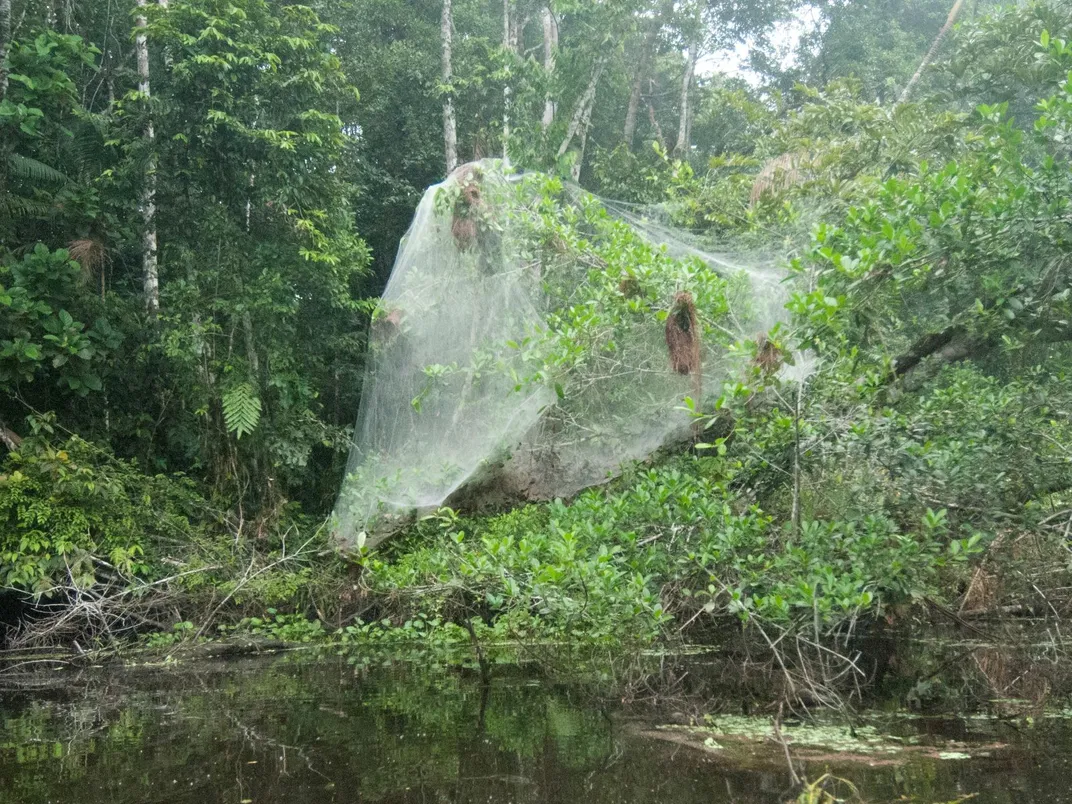
Not all spiders are lone hunters. Researchers know of 25 social species out of the 45,000 described. Social spiders often live together in colonies up to 50,000 strong (although a membership of around 1,000 is usually the optimum size). Working together, such an army of arachnids can build impressive homes of silk. The Anelosimus eximius spider colony in South America can spin webs spanning 25 feet in length, constituting one of the largest silken sanctuaries in the natural world.
Only the female members—outnumbering the males upwards of five to one—work together to build, repair and clean their home. The large numbers of the colony and gargantuan web come in handy when the spiders go after larger prey that an individual can’t take on alone. The spiders work as a team to bring down these larger insects, such as grasshoppers or butterflies, by overwhelming the victims with their numbers.
If the Anelosimus webs are disturbed by predatory swarms of ants or wasps, the spider troops can mount a defense in return. The vibrations of the interlopers are easily transmitted to the vast webs, which disables any surprise attack. The victor of the battle, spider or otherwise, will have a bountiful meal from the fallen.
Large webs of silk are no good against larger animals, especially birds that pilfer the silk to adorn their own nests.
As Drinking Fountains
A wolf spider sits in a web covered in water droplets in Indonesia. dikkyoesin1 via Getty Images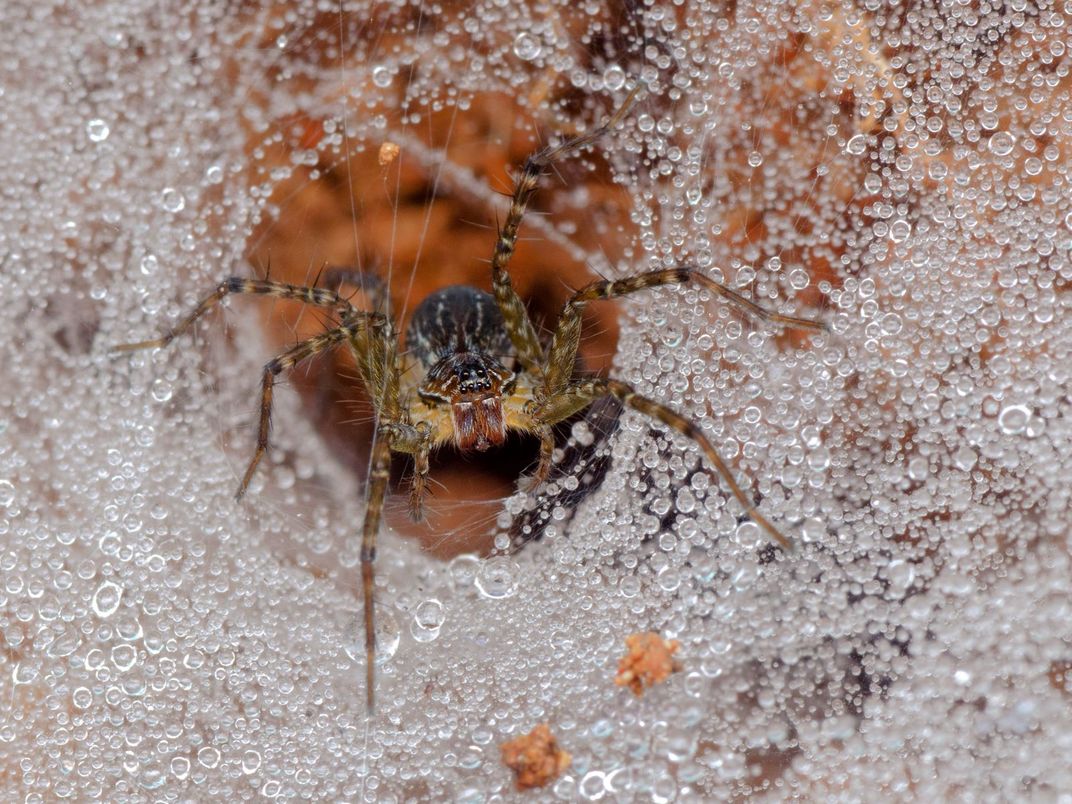
While spiders usually quench their thirst by sucking on the juices of their prey, they can also hydrate themselves the traditional way by imbibing directly from water droplets or small puddles. To save themselves a trip to a water hole, they occasionally sip on the droplets that condense on their webs.
Spider silk can be excellent at drawing moisture from the air. Researchers studied the silk of cribellate spiders and found that the key to its water collecting property is the fiber’s shifting structure itself. In the presence of humidity, the filaments scrounge up into knotty puffs spaced between smooth untangled strands to look like threaded beads on a string. These knotty puffs are moisture magnets. When water condenses onto the silk, the droplets will slide along the smooth regions towards the puffs and coalesce into larger globules there.
The knobby structure of this silk is so efficient at sucking water out of thin air, that it has inspired scientists to develop similar materials in hopes to harvest water from fog.
As Food
The worst kind of roommate, an Argyrodes elevatus spider sits on a yellow garden spider web that’s not of its own making. The spiders are known to steal prey and silk from others. Katja Schulz via Flickr under CC BY 2.0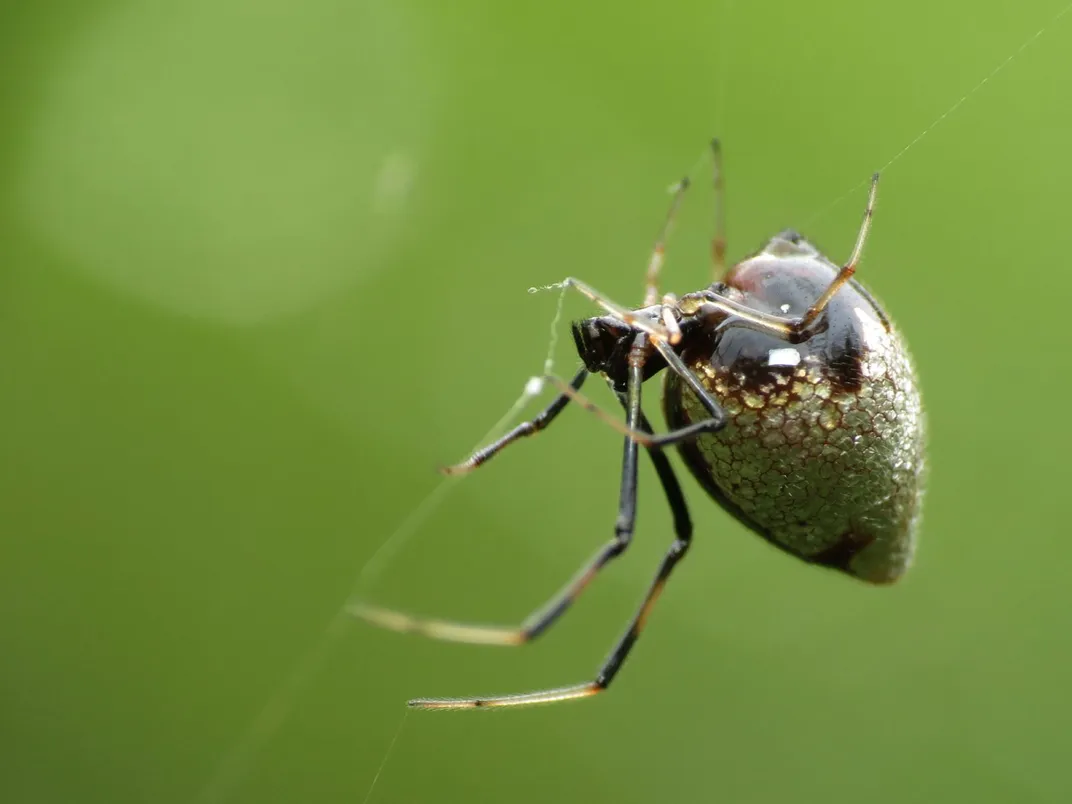
The proteins in spider silk are a valuable commodity. Making silk demands energy on the spider’s part, so sometimes it will eat its own silk, allowing its body to recycle the proteins to make new silk. Many spiders routinely tear down their webs and begin again, so they may as well recycle their building materials.
The Argyrodes spider, or dewdrop spider, takes silk eating to a whole new level—by robbing other spiders’ silk. This spider is a kleptoparasite, which means it pilfers the insect bounty of other spiders rather than hunt for its own. It occasionally does more than steal—it may even move in and prey on the host. During lean times when other spiders can’t land a catch, dewdrop spiders will still steal from the poor by eating the host’s webs instead. Their web heist is a temporary foraging strategy to get by when food is scarce for everyone. Researchers have observed in the lab that the veritable thieves can gorge on the same amount of silk as they would insects.
As Wrapping Paper
A nursery web spider is called what it is for good reason: the females are well-known for constructing a conspicuous egg sac out of silk as a nursery. Mothers are fiercely protective—they will carry their egg sacs in their jaws wherever they roam. When the eggs are about to hatch, the mother will spin a nursery “tent” and place the eggs inside. Then, she stands guard outside and fends off predators until her young are old enough to make their own way out into the world.
Females aren’t the only ones with a creative use of silk. Males spin the material into wrapping paper. As a token of sincerity, a male nursery web spider uses his silk to gift wrap a food item and present it to a suitor. The cost is high if he shows up empty handed: The female usually eats him. Nuptial gifts, as the silk-wrapped dowries are called, help prevent sexual cannibalism by females and extend mating time, keeping the legged ladies occupied with unwrapping presents as males have their way with the females. Researchers have demonstrated that a female is over six times more likely to eat a prospective mate if he shows up sans souvenir, whether she’s hungry or not.
“Some [males] are actually quite naughty,” says Vollrath. Sometimes, the packages “don’t even have a fly inside.” Wily males may take shortcuts—instead of investing the effort into preparing a nutritious gift, males may cheat and wrap fake ones, such as inedible plant seeds, meal leftovers or pebbles. A male might get away with the trickery and squeeze in a quickie, but the female usually cuts their romantic time short after she discovers the ruse. The deception of the nursey web male is a razor edge’s balance between cost and benefit: He may save his energy by preparing a worthless gift for the female; but on the other hand, he may not receive enough time to copulate or he may get eaten.
As Bondage During Mating
A puny male Nephila pilipes spider might bind a cannibalistic female before mating with her. This pair was photographed at Airlie Beach in Queensland, Australia. 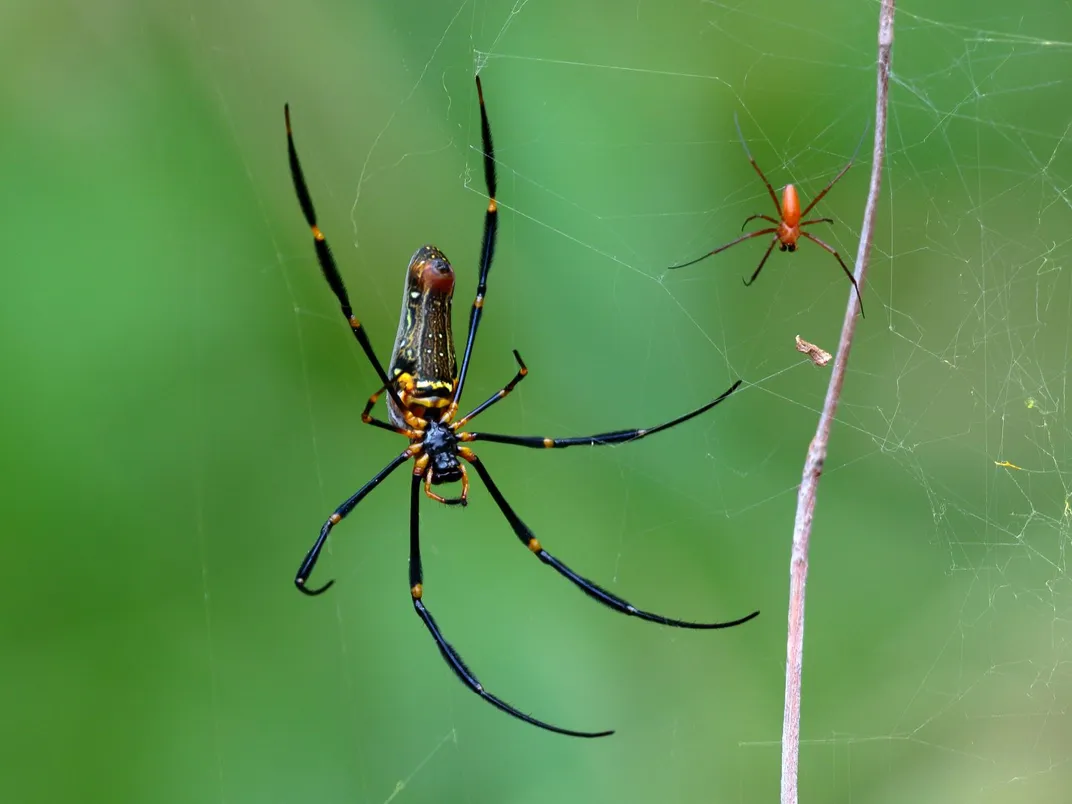
Prospective brides of many spider species are fearsome creatures—they may eat any male who dares approach. A male spider may thwart a female from eating him by binding her with his silk before mating.
Some spiders restrain the female by tying her entire body to the ground; other males throw over their brides a light veil of silk that’s infused with pheromones to turn her on. Researchers have shown that this sparse silk also soothes the female like would a weighted blanket. The Ancylometes bogotensis spider trusses a female up only by the legs, then tips her on her side to mate with her. This foreplay is done out of sheer necessity—females are generally bigger and more aggressive than the males. In the case of Nephila pilipes, the female is ten times larger and 125 times heavier. And females have no trouble freeing themselves from the bindings after mating.
As a Chemical-Soaked Road
Wolf spiders are wandering arachnids that don’t spin webs, but do use silk to drop chemical cues. Joshua Innes via Getty Images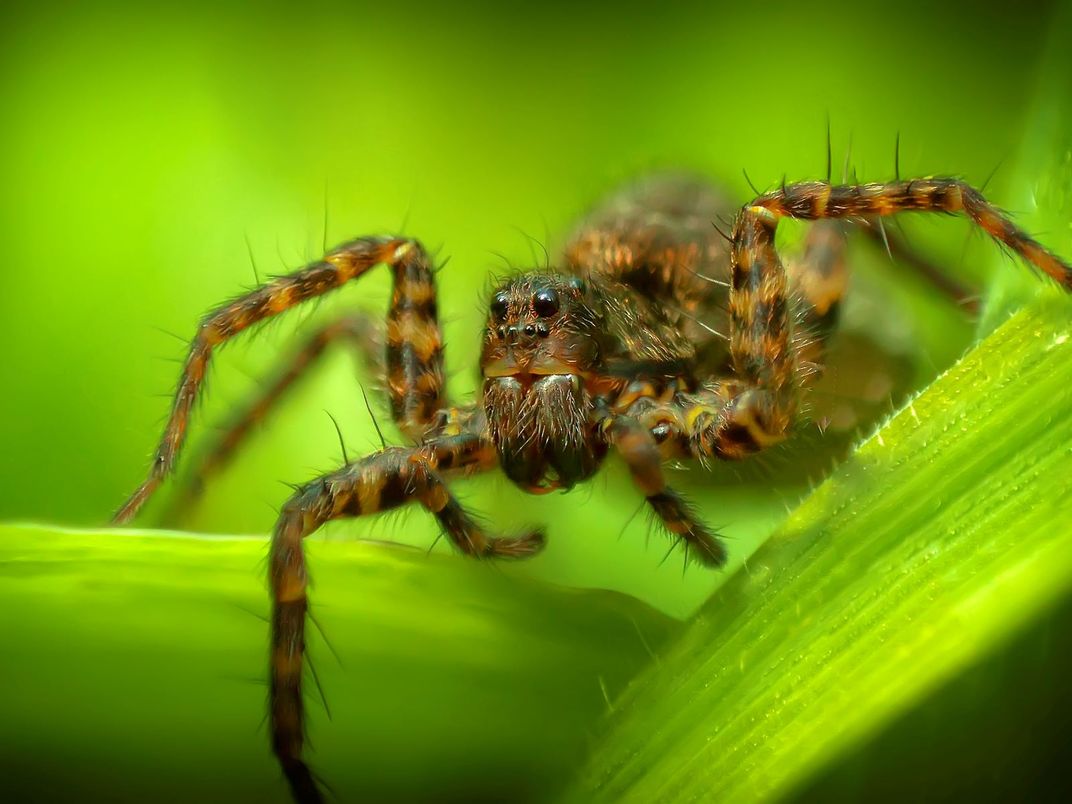
Wandering wolf spider females play hard to get. To broadcast that they’re single and ready to mingle, they’ll leave a trail of silk as they roam. This ‘silk road’ contains sex pheromones, coy come-hither chemical signals that will send males on a merry chase. In fact, males of a particular species of wolf spiders, the Schizocosa ocreata, are able to distinguish the virgin adults from the prepubescent females from the chemicals in the silk fibers. They prefer to chase the sexually mature females to boost their reproductive success.
Males that catch a whiff will put on a courtship display, even before reaching the female. The flamboyant show is energetically costly and may make him more visible to predators. But researchers think there’s still an evolutionary advantage to putting on a show without that coy female in the audience. The performance is a wily shortcut. The males simply hope to attract the notice of other females that happen nearby, and perhaps send out an early message to interested females not to eat the eager courters.
As a Communication Tool
The Portia fambriata spider strums spider silk like a guitar to draw in other spiders as prey. Hua Ming Lee via Getty Images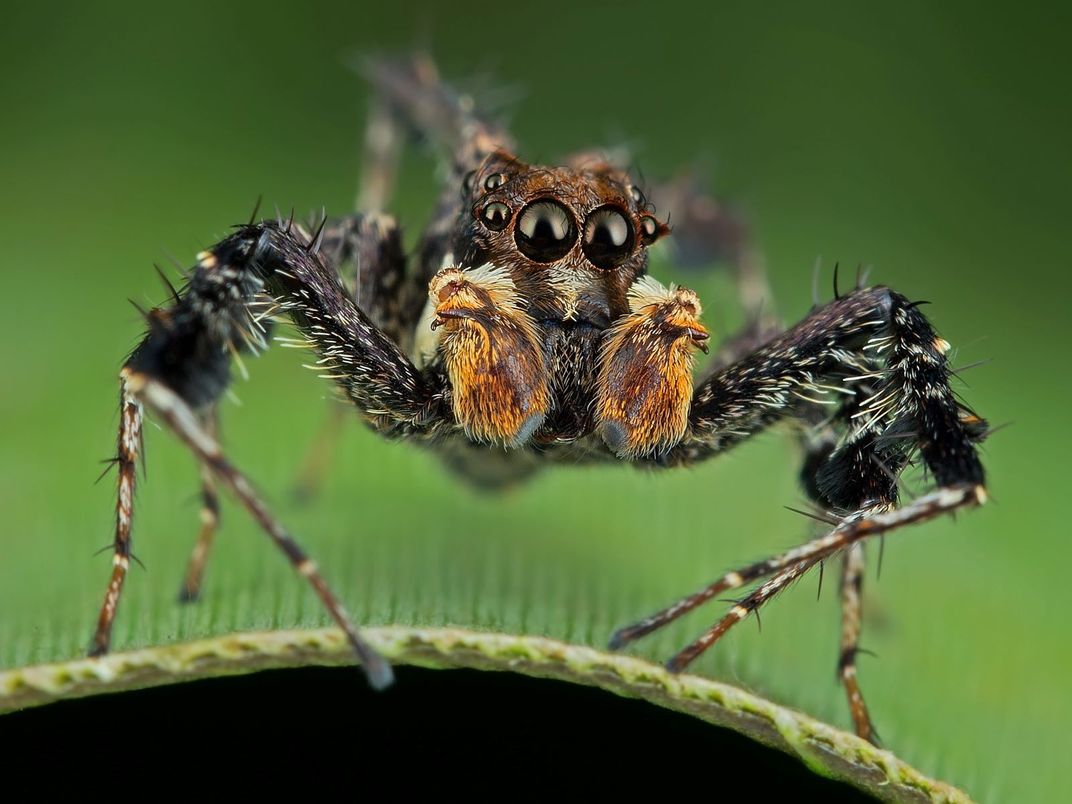
Spiders are extraordinarily sensitive to vibrations. They can sense their prey through the miniscule tremors in the silk. Silk also provides the perfect platform for arachnids to communicate from a distance by plucking the strands or rumbling their abdomens. Spiders may communicate back and forth along a silk thread during courtship, so a male can test the waters before approaching a standoffish female to avoid getting eaten. If the female is receptive, she might just strum back.
Spiders, if it still isn’t clear, can be devious creatures. One cannibalistic spider has learned how to mimic the vibrations of an insect caught in a trap. It drops by other spiders’ webs, strums its song to lure victims into a corner, then ambushes them. The Portia jumping spider is famous for its intelligence, using trial and error to “compose” the right signals until they successfully pique the curiosity of prey. One particularly persistent Portia has been observed to keep up its experimental strumming for three days, before its prey finally decided to investigate.
Portia spiders will make a move on any spider that’s up to twice its size, so when dealing with the larger spiders, the cannibals need to quiver with caution, lest they become the prey instead. Again, this brainy spider experiments with different beats, perhaps plucking a monotonous melody that calms larger spiders. Or, its rhythm may orient the victim-to-be in a particular direction so the Portia may attack its prey from a safer angle. The impressive range of Portia’s tactics is the hallmark of the spider-eat-spider world that arachnids live in.
“[Spiders] have taken every single possible aspect of being a spider and just run with it in completely different directions,” says Echeverri.“Spiders do ‘spider’ in completely different ways.”
For all the latest Science News Click Here
For the latest news and updates, follow us on Google News.


/https://tf-cmsv2-smithsonianmag-media.s3.amazonaws.com/accounts/headshot/Headshot2-2.jpg)